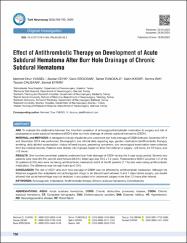| dc.contributor.author | Yüksel, Mehmet Onur | |
| dc.contributor.author | Çevik, Serdar | |
| dc.contributor.author | Erdoğan, Barış | |
| dc.contributor.author | Tunçkale, Tamer | |
| dc.contributor.author | Katar, Salim | |
| dc.contributor.author | Işık, Semra | |
| dc.contributor.author | Evran, Şevket | |
| dc.contributor.author | Çalışkan, Tezcan | |
| dc.date.accessioned | 2022-05-11T14:34:48Z | |
| dc.date.available | 2022-05-11T14:34:48Z | |
| dc.date.issued | 2020 | |
| dc.identifier.issn | 1019-5149 | |
| dc.identifier.uri | https://doi.org/10.5137/1019-5149.JTN.30423-20.3 | |
| dc.identifier.uri | https://hdl.handle.net/20.500.11776/8099 | |
| dc.description.abstract | AIM: To evaluate the relationship between the time from cessation of anticoagulant/antiplatelet medication to surgery and risk of postoperative acute subdural hematoma (ASDH) after burr hole drainage of chronic subdural hematoma (CSDH). MATERIAL and METHODS: A retrospective study of patients who underwent burr hole drainage of CSDH between December 2014 and December 2019 was performed. Demographic and clinical data regarding age, gender, medication (antithrombotic therapy), smoking, daily alcohol consumption, history of head trauma, presenting symptoms, and neurological examination were collected from the medical records. Patients were divided into 3 groups based on time from referral to surgery: <24 hours, 24-72 hours, and >72 hours. RESULTS: One hundred seventeen patients underwent burr hole drainage of CSDH during the 5-year study period. Seventy-two patients were male (61.5%) and 45 were female (38.5%). Mean age was 70.5 +/- 7.2 years. Postoperative ASDH occurred in 2 of the 32 patients (6.3%) who were not taking antithrombotic medication and 6 of the 85 patients (7.1%) who were taking antithrombotic medication. The difference was not significant (p=0.797). CONCLUSION: The risk of ASDH after burr hole drainage of CSDH was not affected by antithrombotic medication. Although the literature suggests that antiplatelet and anticoagulant drugs to be discontinued between 5 and 7 days before surgery, our results showed that acute hemorrhage was not detected in any patient who underwent surgery more than 72 hours after referral. | en_US |
| dc.language.iso | eng | en_US |
| dc.publisher | Turkish Neurosurgical Soc | en_US |
| dc.identifier.doi | 10.5137/1019-5149.JTN.30423-20.3 | |
| dc.rights | info:eu-repo/semantics/openAccess | en_US |
| dc.subject | Anticoagulant | en_US |
| dc.subject | Antiplatelet | en_US |
| dc.subject | Antithrombotic therapy | en_US |
| dc.subject | Chronic subdural hematoma | en_US |
| dc.subject | Complications | en_US |
| dc.subject | Surgical-Treatment | en_US |
| dc.subject | Natural-History | en_US |
| dc.subject | Management | en_US |
| dc.subject | Antiplatelet | en_US |
| dc.subject | Recurrence | en_US |
| dc.subject | Impact | en_US |
| dc.title | Effect of Antithrombotic Therapy on Development of Acute Subdural Hematoma After Burr Hole Drainage of Chronic Subdural Hematoma | en_US |
| dc.type | article | en_US |
| dc.relation.ispartof | Turkish Neurosurgery | en_US |
| dc.department | Fakülteler, Tıp Fakültesi, Cerrahi Tıp Bilimleri Bölümü, Beyin ve Sinir Cerrahisi Ana Bilim Dalı | en_US |
| dc.identifier.volume | 30 | en_US |
| dc.identifier.issue | 5 | en_US |
| dc.identifier.startpage | 758 | en_US |
| dc.identifier.endpage | 762 | en_US |
| dc.institutionauthor | Tunçkale, Tamer | |
| dc.institutionauthor | Çalışkan, Tezcan | |
| dc.relation.publicationcategory | Makale - Uluslararası Hakemli Dergi - Kurum Öğretim Elemanı | en_US |
| dc.authorwosid | tunçkale, tamer/AAC-4928-2021 | |
| dc.authorwosid | EVRAN, Sevket/AAG-3284-2019 | |
| dc.authorwosid | Çevik, Serdar/G-7161-2018 | |
| dc.identifier.wos | WOS:000574422300017 | en_US |
| dc.identifier.pmid | 32996579 | en_US |



















